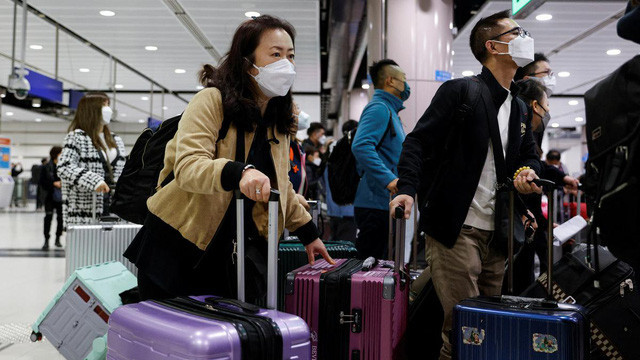Vietnam competes to lure Chinese travelers
Vietnam needs to make efforts to change the perception of the country as a low-cost destination and lure more upscale Chinese tourists.
The border gates between China and other countries, including Vietnam, are seeing thousands of entries and exits as China officially reopened its border on January 8, 2023. The number of people registering for international travel is increasing sharply.
On Trip.com, the number of hotel room bookings by Chinese in Singapore, Kuala Lumpur (Malaysia), Pattaya, Chiang Mai (Thailand) and Milan (Italy) has soared by 500 percent. The number of orders for visa services to the US, Australia and Japan has also increased.
However, Vietnam is not among the destinations chosen by Chinese travelers.
Ngo Lan Phuong, CEO of Kim Lien International Travel, said Chinese tourism companies will only resume their operation after Lunar New Year holiday. However, Vietnam’s tourism not only has to compete fiercely with Thailand and Southeast Asian countries, but also the European market and the Chinese domestic market to lure Chinese travelers.
According to Phuong, Morocco is not a rich country, but it waives visas for travelers of 34 countries, including China. Phuong, who returned recently from the world’s largest tourism fair in the UK, said Chinese agents were welcome there.
European countries also want to receive high-income Chinese travelers.
However, as the EU and some countries apply strict anti-pandemic measures, about 51 percent of Chinese travelers booking outbound tours have changed their itineraries. Most of them have shifted to tours to Asia, especially ASEAN, which have simpler procedures.
This is a great opportunity for Vietnam to attract Chinese travelers.
Chinese domestic travel is also attractive, which poses a great challenge for Vietnam. However, domestic travel costs can be higher than outbound tourism and airfares to some localities in China are as high as air tickets to Vietnam.
Vietnam still has its own advantages in luring Chinese.
But most travel firms and management agencies think the number of Chinese travelers to Vietnam will not recover quickly.
According to Nguyen Quang Thang, CEO of Tictours, even flights which have been scheduled may face cancellation.
Vietjet Air’s first flight carrying Chinese to Cam Ranh may not be scheduled because of problems with the visa policy.
From January 18 to January 26, 2023, only eight flights to and from Vietnam and China are scheduled, departing/landing in Cam Ranh Airport. It is expected that each flight will carry 150-180 passengers, which means 1,000 passengers in total.
According to Vietnam Airlines, the national flag air carrier, China has loosened requirements on medical measures, but there have not been official notices about visa policies from both countries, so the recovery of Chinese travelers will only become stable from April.
The number of travelers is expected to be 70 percent of that in 2019 in Q2 and 90 percent in Q4.
Cao Tri Dung, chair of the Da Nang Tourism Association, thinks that June and July will be the high season for Chinese tourists to return to Vietnam, so Vietnam’s agencies and travel firms need to discuss solutions to receive travelers.
‘Low-cost destination’ perception
Ngo Lan Phuong, CEO of Kim Lien Travel, which specializes in receiving Chinese travelers, admitted that Vietnam still cannot attract high-income Chinese.
In Chinese thoughts, Vietnam provides low-cost and low-quality services. The Chinese traveling in Vietnam in the past were mostly older and retired people who crossed border gates to enter Vietnam.
They just need to book tours at the low price of hundreds of yuan (some Chinese travel agents sold tours at just 200 yuan per traveler).
Many Chinese visited Vietnam under ‘zero dong’ tours, which was a contentious issue for Vietnam as this caused tax evasion and losses to the state budget.
According to Lien, to attract high-income Chinese travelers and sell tours at high prices, Vietnam’s travel firms need to offer attractive options and tours with new experiences.
She said Chinese high income earners are generous and are willing to spend money on spa, healthcare services, food and shopping.
Talking about the difference between European and Chinese travelers, Phuong said while European travelers spend $200 to book a tour and don’t spend much more money on other things, Chinese travelers buy tours at $100 but spend $500 on other services.
As Chinese GDP per capita has increased, Chinese are willing to spend money on outbound tours.
The problem is that Vietnam still cannot connect with large Chinese travel firms. It is necessary to squeeze into the firms’ sales networks.
Vietnamese companies are trying to approach the firms. Pham Van Hiep from Sungroup said his firm has contacts with Chinese travel firms that provide higher income tourists in large quantities who travel with authentic tours, not travelers who cross border gates.
Ngoc Ha
Source: https://vietnamnet.vn/en/vietnam-competes-to-lure-chinese-travelers-2100736.html


 English
English




